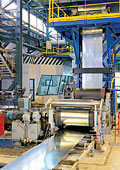 |
| In short supply: A steel plant churns
out coils |
Indian
commodities companies are adding huge capacities. The cement industry,
which has clocked a compounded annual growth rate (CAGR) of 8
per cent over the last one-and-a-half decades, will increase capacity
by 60 per cent to 240 million tonnes by 2009-10. The scenario
is similar in steel. Tata Steel, sail, Essar Steel and a few others
will add about 15 million tonnes of capacity by 2011, taking the
country's installed capacity from 40 million tonnes per annum
today to 55 million tonnes. If the two mega-projects planned by
posco and Arcelor-Mittal in Orissa and Jharkhand, respectively,
are added, that figure will rise by between 6 million tonnes and
24 million tonnes. Non-ferrous metals companies, especially in
the aluminium and zinc sectors are also in the midst of or are
planning to expand capacities.
Clearly, over the long-term, increased supplies
are expected to arrest and even retard the rising trend in prices.
And the government is also hoping that the ban on wheat futures
coupled with a farmer-friendly Budget will rein in prices of this
essential staple. Anil Singhvi, Managing Director of Gujarat Ambuja
Cements (GACL), says: "But capacities cannot materialise
overnight; prices will drop when they do."
And therein lies the problem. In the short
term (i.e., over the next 2-3 years), there is clearly a mismatch
between demand and supply in key commodities like cement and steel
(See Hard Pressed). "The growth in capacities will come in
phases and that might take care of the rising demand every year,"
says Sanjay Kumar Jain, Senior Research Analyst at Motilal Oswal
Securities, a stock broking and research firm. But will that be
enough? "If the growth rate continues, I see the housing
boom sustaining. Besides, I do not see a fall in growth rates
from the current levels to 5-6 per cent," says J. Mehr, Director,
Essar Group. In fact, the surge in prices over the last couple
of years and the future demand potential is attracting new entrants
like FMCG player Emami Group into the cement manufacturing.
Economists say that metals like steel and
aluminium can be easily imported and that their prices are now
dictated by global factors. So, even if the supply increases,
the pricing issue will still be dictated by the global factors.
(See Dearer Metal)
 |
| Under pressure: Cement prices have been
reined in |
On the other hand, there is also a danger
that the additional capacities will hit the market around the
same time, thus, bunching up the incremental supplies. The sugar
industry is a good example: when prices were firm a couple of
years ago, the industry increased capacities. Result: there's
an oversupply in the market, which is dragging down prices. "Lingering
dangers remain on this count," says Singhvi. "And it's
important to understand that commodity prices move in cycles,"
says Essar's Mehra.
The memory of the mid-90s, when many commodities
were in oversupply, is still fresh in the minds of India Inc.
Analysts, however, argue that the situation today is different.
"There was lot of debt financing then and the economy was
also not growing at the pace it is now," says Vinay Patel,
Economist at ICICI Securities. The implication: the economy today
has the wherewithal to absorb any new capacities that are coming
up. Reason: the government and the private sector plan to invest
$350 billion (Rs 15,75,000 crore) on beefing up the country's
infrastructure over the next five years. This will sustain and
expand the current demand for cement, steel and other commodities
for at least another 7-10 years.
Mohan Goenka, Director, Emami Group, sums
up the debate. "There is plenty of room for the industry
as a whole to expand. Look at China; it has a cement capacity
in excess of 1,000 million tonnes," he says.
So, will prices fall when the new capacities
hit the market? The broad consensus on that is: yes, they will,
but only after the supply crunch eases after 2-3 years. The caveat:
there will be short-term spikes whenever there is a temporary
mismatch between demand and supply.
|






